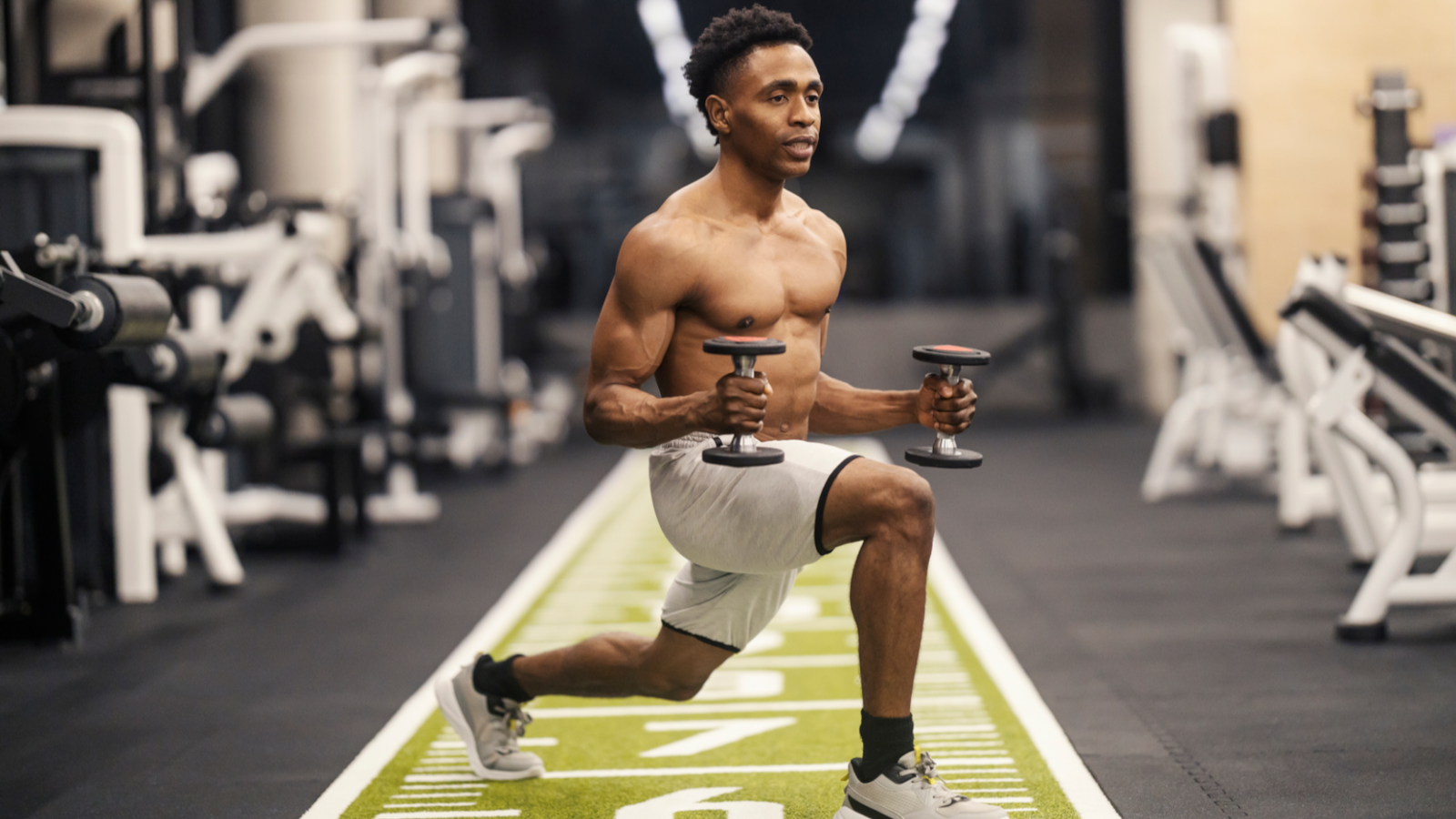Are you wondering if you can build real muscle with just dumbbells? You’re not alone.
Many people think you need a full gym or fancy machines to get strong and toned. But what if all you have are a pair of dumbbells? The good news is, you can make serious gains using just those simple weights.
You’ll discover how to maximize your muscle growth with dumbbells, avoid common mistakes, and create a workout plan that fits your goals. Ready to see what your dumbbells can really do? Keep reading to unlock the secret to building muscle without complicated equipment.
Benefits Of Dumbbell Training
Dumbbell training helps you build muscle effectively. You can work many muscles using just dumbbells.
Dumbbells allow different exercises that suit your strength and goals. They also improve your workout quality.
Versatility And Range Of Motion
Dumbbells offer many exercise options. You can move your arms and legs freely while lifting.
This wide range of motion helps muscles work naturally. You can target small and large muscles well.
- Perform presses, curls, rows, and more
- Adjust angles to focus on different muscles
- Move joints through full natural paths
Improved Muscle Balance
Dumbbells work each side of your body separately. This helps fix strength imbalances.
Balanced muscles reduce injury risks and improve posture. You get stronger on both sides evenly.
- Prevent one side from dominating
- Build equal strength and size
- Enhance coordination between muscles
Convenience And Accessibility
Dumbbells are easy to use at home or gym. They do not need much space or special setup.
You can train anytime without waiting for machines. Dumbbells are affordable and portable.
- Use at home, park, or gym
- Store easily in small spaces
- Adjust weights quickly for all levels

Effective Dumbbell Exercises
You can build muscle using only dumbbells. Dumbbells let you work many muscles at home or gym.
This guide shows dumbbell exercises for upper body, lower body, and core strength.
Upper Body Moves
Dumbbells target arms, chest, shoulders, and back. These moves increase muscle size and strength.
Try these exercises to build your upper body muscles effectively.
- Bicep Curls: Lift dumbbells by bending your elbows.
- Shoulder Press: Push dumbbells overhead to work shoulders.
- Chest Press: Lie down and push dumbbells up from chest.
- Dumbbell Rows: Pull dumbbells toward your waist for back strength.
- Tricep Kickbacks: Extend your arms backward to work triceps.
Lower Body Workouts
Dumbbells help strengthen your legs and glutes. Use them to add weight and resistance.
These exercises improve muscle tone and power in your lower body.
- Goblet Squats: Hold a dumbbell close to your chest and squat down.
- Lunges: Step forward holding dumbbells, then bend knees.
- Deadlifts: Lower dumbbells in front of legs, then stand up straight.
- Calf Raises: Hold dumbbells and lift heels to strengthen calves.
- Step-Ups: Step on a platform with dumbbells in hand.
Core Strengthening
Dumbbells also work your core muscles. These moves improve balance and stability.
Try these exercises to build a stronger midsection.
- Russian Twists: Sit and twist torso holding one dumbbell.
- Dumbbell Side Bend: Stand and bend sideways holding a dumbbell.
- Weighted Sit-Ups: Hold a dumbbell on your chest while doing sit-ups.
- Renegade Rows: In plank position, row dumbbells one arm at a time.
- Standing Woodchoppers: Swing a dumbbell diagonally across your body.
Designing A Dumbbell Workout Plan
Building muscle with dumbbells is possible with the right workout plan. Dumbbells offer many exercise options to target different muscles.
A good plan includes picking the right weight, setting reps and sets, and allowing rest for recovery.
Choosing The Right Weight
Pick dumbbells that challenge your muscles but let you keep good form. Too light weights won’t build muscle well.
Start with a weight that lets you do 8 to 12 reps with effort. Increase weight as you get stronger.
- Use lighter weights for smaller muscles
- Use heavier weights for bigger muscles
- Adjust weight if you cannot complete your reps
Setting Reps And Sets
Muscle growth happens with enough reps and sets. Aim for 3 to 4 sets of 8 to 12 reps per exercise.
Keep reps in this range to create muscle tension and fatigue. Lower reps build strength, higher reps build endurance.
- 3-4 sets per exercise
- 8-12 reps per set for muscle growth
- Rest 30-60 seconds between sets
Rest And Recovery
Muscles grow during rest, not while you train. Give each muscle group 48 hours to recover before working again.
Rest helps repair muscle fibers and reduces injury risk. Sleep and good nutrition also support recovery.
- Rest muscle groups at least 2 days
- Get 7-9 hours of sleep each night
- Eat protein to help muscle repair
Progressive Overload With Dumbbells
Building muscle needs your muscles to work harder over time. Progressive overload means increasing the challenge step by step. Dumbbells are great tools for this process.
You can increase weight, adjust your workout volume, and track progress to build muscle effectively with dumbbells.
Increasing Weight
Lifting heavier dumbbells makes your muscles grow stronger. Start with a weight you can lift well. Slowly add more weight as exercises get easier.
Adding weight forces muscles to adapt and grow. This is a key part of progressive overload.
Adjusting Volume And Intensity
Volume means how many sets and reps you do. Intensity means how hard your muscles work. You can change both to keep challenging your muscles.
- Increase sets or reps to add volume
- Use slower movements to raise intensity
- Reduce rest time between sets
Changing these factors helps muscles grow without always adding weight.
Tracking Progress
Write down the weights, sets, and reps you do each workout. Tracking helps you see improvements over time.
Use a notebook or an app to record your progress. This keeps you motivated and focused on your goals.
Common Mistakes To Avoid
Building muscle with dumbbells is possible, but many people make mistakes. These errors can slow progress or cause injuries.
Knowing what to avoid helps you get better results and stay safe during workouts.
Poor Form And Technique
Using bad form is a common mistake when lifting dumbbells. It can cause injuries and reduce muscle gains.
Focus on slow and controlled movements. Keep your back straight and avoid using momentum to lift weights.
- Do not swing the dumbbells too fast
- Keep your joints stable during exercises
- Use the right weight to maintain proper form
- Watch yourself in a mirror or record your workout
Neglecting Warm-up And Cool-down
Skipping warm-up can cause muscle strains and reduce workout quality. Warm muscles work better and are less likely to get hurt.
Cool-down helps your body recover and lowers soreness after training. Stretching is important after your workout.
- Start with light cardio or dynamic stretches before lifting
- End with gentle stretching to relax muscles
- Spend at least 5-10 minutes warming up and cooling down
Ignoring Nutrition
Muscle growth needs proper nutrition. Without enough protein and calories, your body cannot build muscle well.
Drinking water and eating balanced meals support recovery and energy levels during dumbbell workouts.
- Eat enough protein like chicken, beans, or eggs
- Include healthy carbs and fats for energy
- Stay hydrated before, during, and after workouts

Supplementing Dumbbell Training
Dumbbell training helps build muscle effectively. You can improve results by adding other exercises.
Using different workouts and good nutrition supports muscle growth and overall fitness.
Bodyweight Exercises
Bodyweight exercises improve strength and balance. They work well with dumbbell training.
Exercises like push-ups and squats target muscles in new ways. This helps you build muscle faster.
- Push-ups build chest and arm muscles
- Squats strengthen legs and glutes
- Planks improve core stability
- Lunges target legs and balance
Cardio And Flexibility
Cardio keeps your heart healthy and increases endurance. It helps you recover between weight sessions.
Flexibility exercises reduce injury risk. Stretching improves muscle function and movement quality.
- Walking or jogging for cardio
- Yoga for flexibility and balance
- Stretching after workouts
- Light cardio on rest days
Nutrition Tips For Muscle Growth
Eating the right foods fuels muscle growth. Protein is important for muscle repair and building.
Carbs and fats provide energy for workouts. Drink plenty of water to stay hydrated.
- Eat lean proteins like chicken and fish
- Include whole grains for energy
- Consume healthy fats from nuts and avocados
- Drink at least 8 glasses of water daily

Frequently Asked Questions
Can Dumbbells Alone Build Muscle Effectively?
Yes, dumbbells can effectively build muscle by providing resistance. They allow for a wide range of exercises targeting different muscle groups. Consistency and progressive overload are key. Adjusting weight and reps helps stimulate muscle growth. It’s important to maintain proper form to prevent injury and maximize results.
How Often Should I Use Dumbbells For Muscle Gain?
For effective muscle gain, use dumbbells 3-5 times a week. Allow rest days for recovery and muscle repair. Focus on different muscle groups each session. Consistency and a balanced workout routine are crucial. Listen to your body and adjust frequency as needed to avoid overtraining.
What Dumbbell Exercises Are Best For Muscle Growth?
Key dumbbell exercises include bench presses, deadlifts, and squats. These compound movements target multiple muscle groups. Incorporate bicep curls, shoulder presses, and lunges for isolation exercises. Aim for a balanced workout routine. Gradually increase weight and reps to ensure continuous muscle growth and strength development.
Can Beginners Build Muscle Using Dumbbells?
Yes, beginners can build muscle using dumbbells. Start with lighter weights and focus on proper form. Gradually increase weight and reps as strength improves. Dumbbells offer versatility and control, making them ideal for beginners. Consistency and patience are essential to see progress and build muscle effectively.
Conclusion
Building muscle with dumbbells is totally possible. You can work many muscles at home or the gym. Dumbbells offer variety and help improve strength and shape. Consistency and good form matter most for results. Pair your workouts with proper rest and nutrition.
Keep challenging yourself by adding weight or reps. No need for big machines to grow muscle. Just stay focused, patient, and enjoy the process. Your body will respond to effort over time. Simple tools, smart work—this is how muscles grow.



